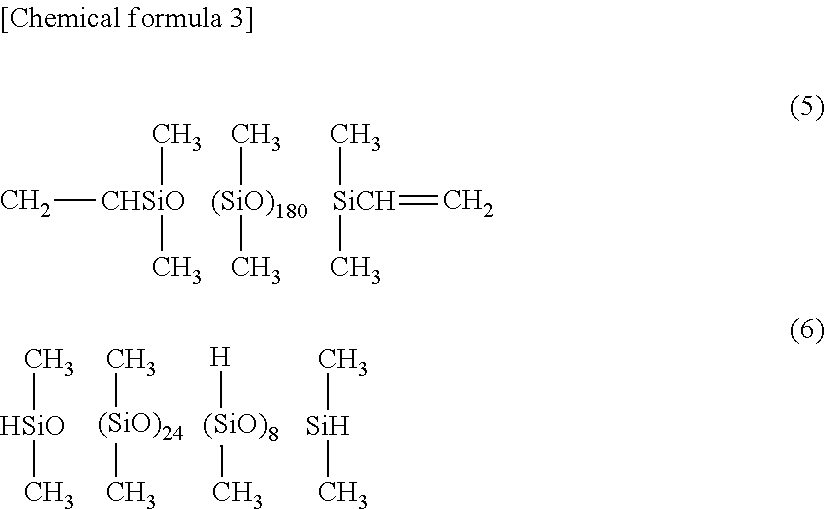Silicone particles and method for producing same
- Summary
- Abstract
- Description
- Claims
- Application Information
AI Technical Summary
Benefits of technology
Problems solved by technology
Method used
Image
Examples
working example
[0082]The present invention is described in greater detail hereunder with reference to working and comparative examples. However, the invention is not limited to these working examples. Particularly, in the examples, a kinetic viscosity refers to a value measured at 25° C.; “%” denoting a concentration and a content rate refers to “% by mass.” Further, dispersibility was evaluated as follows.
Evaluation of Non-Cohesiveness (Measurement of Mesh Passing Amount)
[0083]A 60-mesh sieve, a 100-mesh sieve and a 200-mesh sieve were stacked in this order from the top, followed by weighing about 2 g of a particle sample on the 60-mesh sieve, and then using a powder characteristics tester (powder tester type: PT-E by Hosokawa Micron Group) to cause a vibration with an amplitude of 1 mm for 90 sec so as to then measure a passing amount with regard to each mesh. The mesh passing amount is expressed by %, and it is considered that the larger the passing amount, the higher the non-cohesiveness is.
Me...
working example 1
[0085]Put into a 1 L glass beaker were 500 g of a methylvinylpolysiloxane that is represented by the following formula (5) and has a kinetic viscosity of 600 mm2 / s; and 20 g of a methylhydrogenpolysiloxane that is represented by the following formula (6) and has a kinetic viscosity of 27 mm2 is (amounts at which 1.13 hydrosilyl groups would be present per one olefinic unsaturated group), followed by using a homomixer to stir and melt them at 2,000 rpm. Next, 3 g of a polyoxyethylene lauryl ether (adduct molar number of ethylene oxide=9 mol) and 65 g of water were added thereto, followed by using a homomixer to stir them at 6,000 rpm to obtain an oil-in-water type emulsion with an increased viscosity. There, stirring was further continued for 15 min. Next, as a result of adding water of 410 g while performing stirring at 2,000 rpm, a homogenous white emulsion was obtained. This emulsion was then moved to a 1 L glass flask equipped with a stirring device utilizing an anchor-shaped sti...
working example 2
[0094]Silicone particles were obtained in a similar manner as working example 1, except that 0.4 g of a cationized cellulose (product name: POIZ C-60H by Kao Corporation) (amount equivalent to 0.05 parts by mass per 100 parts by mass of water) was used instead of 1 g of the 40% dimethyldiallylammonium chloride polymer aqueous solution (product name: ME polymer H40W by TOHO Chemical Industry Co., Ltd.).
[0095]The silicone particles obtained were then dispersed in water using a surfactant, and the electric resistance-method particle size distribution measuring device (Multisizer 3 by Beckman Coulter, Inc.) was used to measure the particle size distribution of the silicone particles. As a result, the particle size distribution thereof was at the same level as that of the abovementioned aqueous dispersion of the silicone elastomer particles, and the volume average particle size thereof was 5 μm.
[0096]These silicone particles were observed with an electronic microscope, and it was confirm...
PUM
| Property | Measurement | Unit |
|---|---|---|
| Percent by mass | aaaaa | aaaaa |
| Particle size | aaaaa | aaaaa |
| Molar density | aaaaa | aaaaa |
Abstract
Description
Claims
Application Information
 Login to View More
Login to View More - R&D
- Intellectual Property
- Life Sciences
- Materials
- Tech Scout
- Unparalleled Data Quality
- Higher Quality Content
- 60% Fewer Hallucinations
Browse by: Latest US Patents, China's latest patents, Technical Efficacy Thesaurus, Application Domain, Technology Topic, Popular Technical Reports.
© 2025 PatSnap. All rights reserved.Legal|Privacy policy|Modern Slavery Act Transparency Statement|Sitemap|About US| Contact US: help@patsnap.com



